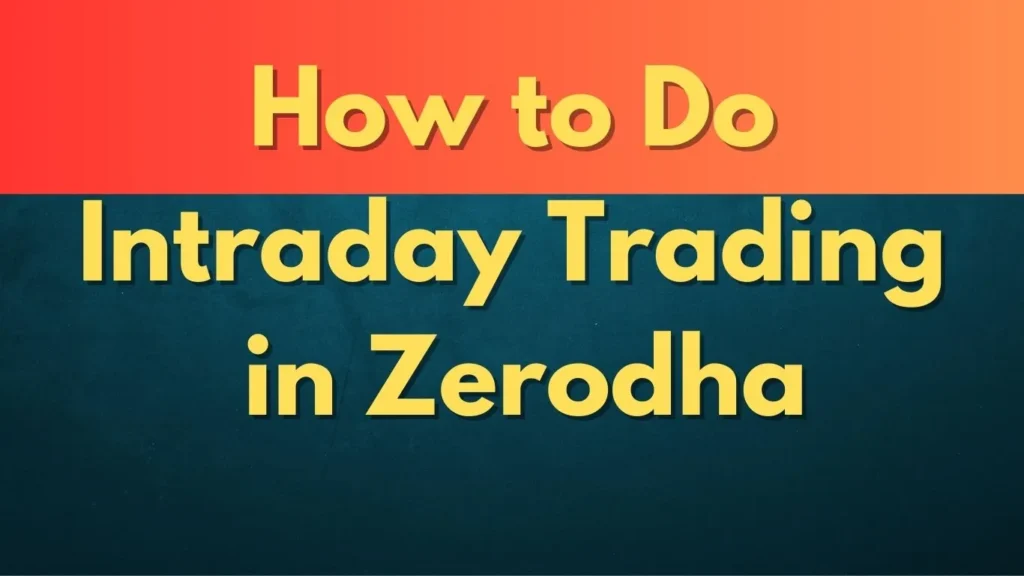Intraday trading, also known as day trading, is a popular form of trading where traders buy and sell stocks within the same trading day, aiming to take advantage of short-term price movements. Zerodha, one of India’s leading discount brokerage firms, offers a user-friendly online platform called Zerodha Kite, which allows traders to easily execute intraday trades. If you are looking to dive into the world of intraday trading in Zerodha, here are five steps to get you started.

Step 1: Login to Zerodha Kite
To begin your intraday trading journey with Zerodha, the first step is to login to your Zerodha Kite account. Zerodha Kite provides a seamless and intuitive interface that enables traders to access real-time market data, charts, and place trades with ease. Simply enter your login credentials, and you will be ready to explore the exciting world of intraday trading.
Step 2: Add Funds
Before you can start intraday trading in Zerodha, it is essential to add funds to your trading account. Zerodha offers multiple convenient options to fund your account, such as net banking, UPI, or through a physical cheque. Once your account is funded, you will have the necessary capital to execute your intraday trades.
Step 3: Shortlist the Stocks in Watchlist
The next step in successful intraday trading is to shortlist the stocks that you will be actively monitoring and trading throughout the day. Zerodha Kite allows you to create a personalized watchlist, enabling you to keep track of your preferred stocks and their price movements. It is crucial to conduct thorough research and analysis to identify stocks with high liquidity, volatility, and potential for intraday trading profits.
Step 4: Observe Market Trend
Before placing any trades, it is important to observe the market trend. Analyzing the overall market sentiment can help you make informed trading decisions. Zerodha Kite provides a range of advanced charting tools and technical indicators to examine the market trend effectively. By studying price patterns, support and resistance levels, and other technical factors, you can identify potential entry and exit points for your intraday trades.
Step 5: Place Order
Once you have identified a favorable trading opportunity, it’s time to place your intraday order on Zerodha Kite. Zerodha offers different order types to suit various trading strategies and preferences. Let’s take a look at some of the commonly used order types in Zerodha for intraday trading.
Intraday Order Types in Zerodha
#1. Market Order
A market order is the simplest type of order, where you buy or sell a stock at the prevailing market price. This order type ensures a quick execution but may not guarantee a specific price.
#2. Limit Order
A limit order allows you to specify the maximum price you are willing to buy or the minimum price you are willing to sell a stock. Your order will only execute if the market reaches your specified price.
#3. Iceberg Order
An iceberg order is designed to hide a large order by breaking it into smaller visible orders. This helps to prevent significant price movements caused by large orders in the market.
#4. Cover Order (CO) in Zerodha
A cover order is a special type of order that combines a market order with a stop-loss order. It is commonly used to limit potential losses and manage risk effectively.
#5. After Market Order (AMO)
An after-market order allows you to place orders before or after regular trading hours. This is particularly useful if you are unable to actively participate in intraday trading during market hours.
Zerodha Intraday Trading Fees
Now, let us discuss various charges including brokerage applicable for Zerodha intraday trading:
Now, what do these charges mean:
Zerodha brokerage charges are charged every time you place an order. With Zerodha, higher trade value does not mean that you will be charged more brokerage, as Zerodha does not charge more than ₹20 per trade, no matter how big the trade value.
STT or Securities Transaction Tax is levied by stock exchanges like NSE or BSE and is generally levied on the sell side of trading.
Turnover fees are charged on both sides of a trade by specific exchanges.
SEBI fees, as the name suggests, is collected by the SEBI regulator itself.
GST or Goods and Services Tax is a tax levied by the Central Government.
Stamp duty is levied by the state government
Apart from these charges, stamp duty and DP charges are also applicable on every transaction conducted through Zerodha Intraday. Stamp duty varies depending on the state and detailed information can be found in the link below:
Furthermore, all the charges and exact brokerage can be calculated through the Zerodha brokerage calculator.
Zerodha Intraday Trading Duration
You can do Zerodha intraday trading any time during the market opening hours. However, you have to be a little careful about understanding your location.
If any intraday MIS/BO/CO orders are open before market close, they are automatically closed at 3:20 PM.
If for some reason, the order for intraday trading is not closed by the time the market closes, the order is converted into a CNC (Cash and Carry) order.
It is rolled over to the next business day and automatically closed by Zerodha if the required amount of cash is not in the account. In such cases, no margin call is performed.
Zerodha Intraday Margin
Trading in futures is done on the basis of leverage, which means that a small amount of money called ‘margin’ is required in your account to trade in intraday futures.
Zerodha’s Margin Calculator gives you complete details of your margin requirements when trading futures.
To get detailed analysis of margin requirements of any trade you need to enter all the information related to the trade. The margin calculator includes hundreds of detailed lists of all stocks as well as MIS and CO/BO margin/leverage.
Learn how to use Zerodha Margin Calculator so that you don’t have any confusion in your mind.
Apart from this you can also get information about the margin to be used after trading in Zerodha Kite.
For more information, check out Zerodha Margin Calculator.
Zerodha Intraday Trading Tips
There is no one formula that everyone can use to make profits through Zerodha intraday trading.
However, there are some quick intraday trading tips that you can choose to adopt in your trades as part of Zerodha Technical Analysis:
Carry out detailed technical analysis of specific sectors or stocks you are monitoring. There are many technical indicators, charts, heat maps, screeners, and other related tools that can help you in making decisions.
Take positions in the market using intraday trading strategies
Use any method of order placement. If it is online, you only have to select a specific number. For example, you can choose to keep the order type as MIS.
Ideally, if your trade moves in the opposite direction to expectations, you should set a stop-loss price to limit your losses in intraday trading.
Trailing stop-loss orders can be beneficial for you to take advantage of higher profits.
Use margin according to your risk appetite. People will tell you that using margin is a double-edged sword. Well, they are exactly right!
FAQs
Can I trade intraday on Zerodha?
Yes, Zerodha provides a user-friendly platform called Zerodha Kite, which allows traders to easily execute intraday trades.
How do I add funds to my Zerodha trading account?
Zerodha offers multiple convenient options to fund your account, such as net banking, UPI, or through a physical cheque.
What is a cover order in Zerodha?
A cover order is a special type of order in Zerodha that combines a market order with a stop-loss order, allowing traders to limit potential losses and manage risk effectively.
Can I trade after regular market hours on Zerodha?
Yes, Zerodha allows traders to place after-market orders (AMO) before or after regular trading hours.
In conclusion, with the right knowledge, tools, and strategies, intraday trading in Zerodha can be a rewarding experience. By following the steps outlined in this article and utilizing the various order types available on Zerodha Kite, you can navigate the intraday trading landscape with confidence and potentially achieve your financial goals.






